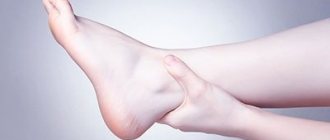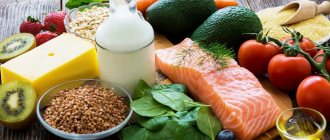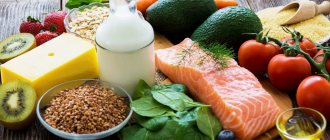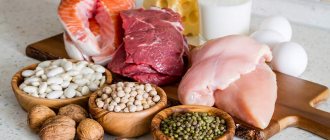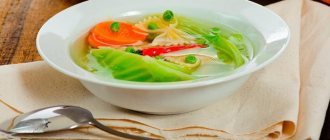In this article we will tell you:
- Causes of edema
- Signs of fluid retention in the body
- Laboratory and functional diagnostics
- Nutrition for edema
- Diuretic foods and drinks
- Prohibited Products
Edema
- a pathology that everyone has invariably encountered in their lives. They are often the first warning signs of an impending threat to an organism in dynamic equilibrium.
When should you start to worry and what systems should you suspect first? Is it possible to prevent their occurrence with nutrition alone? And what, in essence, should be the correct menu if water-salt metabolism is disrupted? We tried to touch upon and reveal all these topics in our article.
Causes of edema
Edema is an accumulation of fluid in the tissues and serous cavities of the human body: abdominal, pleural and pericardial. They are a clear example of a water-electrolyte imbalance and can be either purely local or generalized.
In our body, there are several most important mechanisms for water exchange - for example, one of them, carried out between plasma (that is, the liquid part of the blood, devoid of formed elements: red blood cells, platelets and leukocytes) and intercellular fluid is carried out due to:
- Filtration
- water leaves the vascular bed into the interstitium (connective tissue surrounding the capillaries);
- Reabsorption
- accordingly, it returns back to the systemic circulation.
These physiological processes, which play a key role both in maintaining systemic pressure and in metabolic mechanisms, are strictly regulated and depend, to a greater extent, on pressure values - hydrostatic and oncotic. The formation of the latter involves mainly blood proteins - especially the albumin fraction, which nobly takes on 80% of the total work.
As is known, the liver is the factory for their production - the only exception is another group that primarily performs the function of immune defense - gamma globulins or antibodies produced by the cells obtained during the activation of B-lymphocytes.
On the other hand, we also know that, due to their bulky size, proteins are not able to overcome the kidney filter: its fine-mesh structure remains an impenetrable barrier for them. Thus, we can draw a logical conclusion: pathology of water-salt metabolism occurs in cases where there is a decrease in the synthetic function of liver cells and in inflammatory kidney diseases, accompanied by the release of protein molecules into the urine.
Understanding such details of the metabolism of this class of organic compounds is of considerable diagnostic importance: and all thanks to the ability of proteins to “retain” water.
So, with a decrease in their content in the blood plasma, water will naturally move into the tissue adjacent to the vessels.
The second, no less common cause of edema is disturbances in the formation and/or drainage of lymph.
: the return of water from tissues to the vascular bed is distorted (after all, the lymphatic ducts ultimately flow into large venous trunks). In addition, this is accompanied by a delay in the interstitium and proteins, and we have already mentioned their effect on water metabolism.
In inflammatory and allergic reactions, when under the influence of biologically active substances (so-called inflammatory mediators, the most striking of which, undoubtedly, is histamine), the permeability of the vascular wall increases
, the result of which will be the release of protein molecules into the tissue. A similar mechanism is observed during intoxication.
Edema also occurs with venous stagnation
- this most clearly indicates the pathology of the heart muscle.
As a rule, they appear in the late afternoon, in the afternoon, on the lower extremities and disappear by morning. Their appearance can also be facilitated by thrombosis of the veins
(when their lumen is blocked, further blood flow is disrupted), as well as
by insufficiency of their valves
.
Swelling is also a side effect of some medications.
, the mechanism of which mediates the retention of salt and water in the blood serum. The list of such drugs includes:
- antidepressants;
- antihypertensive;
- antivirus;
- cytokines and some hormonal drugs;
- non-steroidal anti-inflammatory drugs (ibuprofen in particular).
The last and perhaps most common cause is hypothyroidism.
- decreased functional activity of the thyroid gland.
With this disease, mucous swelling appears: and all due to an increase in the ability of connective tissue components to bind water. Their localization is especially pronounced on the face (around the eyes)
and
limbs: shoulders and legs.
Study
: Edema: Diagnosis and Management
Signs of fluid retention in the body
The most obvious and first coming to mind consequence of water-electrolyte imbalance is increased body weight
. This, it must be said, is due not only to the accumulation of fluid in the tissues, but also implies certain disturbances in the neuro-endocrine apparatus. For example, hypothyroidism (which, as we previously wrote, leads to the appearance of mucous edema) is also accompanied by a significant slowdown in metabolism: in truth, it is difficult to name those functions and biochemical reactions that are not directly or indirectly affected by thyroxine and triiodothyronine.
Systemic causes of edema and some characteristic signs to look for during examination:
- Heart failure
- swelling of the jugular veins;
- swelling in the lower extremities, which appears in the evening and disappears in the morning;
- dyspnea.
- Liver disease
- ascites (accumulation of fluid in the abdominal cavity);
- jaundice.
- Kidney diseases
- proteinuria (detection of protein in urine);
- oliguria (rare urination).
- Thyroid diseases
- googly eyes;
- tremor;
- weight loss.
We recommend
“Interval diet: contraindications and side effects” Read more
It is the search for the original problem that led to the development of edema that is the initial task that a nutritionist or doctor should set. After all, you will agree that diuretics, which we will discuss below, will not always bring the desired effect or at least partially cope with the relief of the main complaints and symptoms.
“idiopathic edema” is still used.
- this term reflects weight gain without an obvious reason. In other words, this is rather a diagnosis of exclusion: the disease has an incomprehensible, inexplicable (at least at this stage of medical development) etiology.
We have presented several algorithms by which you yourself could suspect (we repeat, in the absence of any characteristic symptoms from other organs and systems) idiopathic edema. So, they are characterized by:
- periodic swelling of the extremities;
- bloating;
- increase in body weight in the afternoon by 1.4 kg or more;
- menstrual irregularities;
- vegetative-vascular dystonia;
- pathologies of carbohydrate metabolism.
Laboratory and functional diagnostics
When edema appears, it is necessary to establish the cause that caused it: only this will allow for complex therapy and adequate correction of the diet with the introduction of the necessary support with nutraceuticals.
First of all, it is necessary to ensure the adequate process of protein breakdown and their further absorption: we have already talked about the leading role of this class of organic compounds in ensuring the proper values of oncotic blood pressure, which, in essence, creates all the conditions for water filtration or its reabsorption.
Inflammatory processes in the gastric mucosa, the spread of H. pylori throughout its entire perimeter, and a decrease in the number of cells secreting hydrochloric acid (which, in particular, is characteristic of atrophic gastritis, which is usually of an autoimmune nature) require targeted attention from specialists.
The first and main diagnostic test that is prescribed in such cases is fibrogastroduodenoscopy
, a non-severe invasive intervention,
with mandatory biopsy and pH-metry
(measuring the acidity of gastric juice). This is necessary not only to form a complete picture, but also to prevent severe complications: it all starts with chronic gastritis and in most cases, in an unfavorable situation, ends with stomach cancer.
Alternatively, a betaine-pepsin test
(only if the integrity of the gastric mucosa is preserved - otherwise, this will become a powerful trigger, significantly irritating the wound surface and slowing down the healing process) to establish the acidity of gastric juice: hydrochloric acid, as is known, not only participates in the activation of proteolytic enzymes in the lumen of the stomach, but also contributes to the direct degradation of protein molecules in food. Along with foods rich in proteins, you need to take one capsule of betaine-pepsin - a complex containing a drug that increases the level of acidity and an enzyme that breaks down the chemical bonds between amino acids in the structure of peptide fragments. Then, only if the supplement is well tolerated, you can gradually increase the dose - however, it should not exceed 6 capsules (please take into account the variability of dosages from different manufacturers: we deliberately do not indicate them in the article, since we believe that even this diagnostic measure should carried out strictly under the supervision of a nutritionist or doctor). The maximum tolerated dose is determined by subjective sensations - before the onset of burning and heartburn. After achieving it, you should also reduce the dose by 1 tablet with constant recording and monitoring of your condition.
As a diagnosis of Helicobacter infection
(although most of the population becomes infected already in childhood and, we repeat, not all cases require treatment: it all depends on the pathogenicity of the strains and the nature of the process - is it localized or the bacteria are spread throughout the entire perimeter of the stomach)
are used
:
- Determination of specific antibodies in blood serum.
- Breath tests with labeled urea (most preferred).
- Detection of bacterial antigens in feces.
In addition to disorders of the stomach, the main site of breakdown of protein molecules, intestinal pathology
: It is on the epithelial villi that the absorption of all compounds of various organic classes occurs.
So, say, with celiac disease
- a fairly common autoimmune disease - the absorption of most biologically active compounds is impaired (you can learn more about diagnosis and therapy from our article on the effect of gluten on the human body:).
Sometimes protein deficiency may be associated with exocrine pancreatic insufficiency
or
disturbances in the formation and outflow of bile
, which acts as an activator of pancreatic enzymes. In such cases, the reason for the stagnation of this golden secretion or the decrease in its production by liver cells is determined, and an individually selected set of drugs for enzymatic support is prescribed.
It is usually not difficult to suspect cholestasis
, since it is accompanied by characteristic, well-defined signs:
- constipation, followed by diarrhea with foul-smelling and greasy stools;
- itching of the skin that does not have a specific localization;
- headache;
- weakness due to intoxication;
- discomfort in the right hypochondrium;
- bitterness in the mouth;
- belching;
- acne.
Laboratory diagnostics
- Thyroid panel for suspected hypothyroidism
:
- TSH;
- T3 free and T4 free;
- antibodies to thyroid peroxidase and thyroglobulin.
In addition, it should be taken into account that with a decrease in the production of thyroid hormones, the hypothalamus, one of the key structures of the brain, begins to naturally release more thyrotropin-releasing hormone, which stimulates not only the production of TSH by the pituitary gland (subsequently affecting the follicles as an activator of the formation of T4 and T3 ) but also prolactin - hyperprolactinemia is noted.
In general, edema caused by insufficient production of thyroid hormones by the thyroid gland already has a fairly clear clinical picture. So, let's say, they are noted
:
- puffy face;
- teeth marks on the tongue;
- fragility and hair loss.
Study
: Therapeutic masks for hypothyroidism
Genetic tests
- Folate cycle genetics: MTHFR, MTR, MTRR.
Nutrition for edema
In general, as previously mentioned, any correction of water-salt metabolism should begin directly with establishing the etiology of edema - that is, the immediate cause that contributes to its development. Only on this basis will a nutritionist or doctor be able to correctly build a diet for the patient, taking into account all the features of his digestive, endocrine and other key systems of the body.
Three meals a day remains the most physiological for the bulk of the population: the complete exclusion of all snacks and maintaining four or five hour intervals between main meals effectively prevents the occurrence of carbohydrate metabolism disorders. However, for example, with adrenal depletion, which will make a significant contribution to the imbalance of water-salt metabolism, such a regimen is not only ineffective, but even contraindicated, which once again emphasizes the need for a purely individual approach.
In general, given that most pathological processes in our body are accompanied by oxidative stress, and modern realities of life predispose to a total deficiency of antioxidants, their replenishment should be carefully monitored - both with food and with dietary supplements, or even (in some cases) with injections. Below we have provided a list of widely available sources of some vitamins and elements involved in protecting our cells from the army of free radicals.
Products, vitamin C
- rose hip;
- sea buckthorn;
- broccoli;
- bell pepper;
- citrus;
- strawberries;
- currant;
- kiwi;
- spinach.
Selenium-rich foods
- chickpeas;
- sunflower seeds;
- eggs;
- beans;
- oat bran;
- rice;
- lentils;
- Brazil nuts;
- seafood.
We also recommend adding sources of dopamine or its immediate precursors to your diet: it is not unreasonably believed that this neurotransmitter prevents, by influencing various parts of the regulation of water-salt metabolism, sodium retention in the body, thereby actively counteracting the development of edema.
Products containing the amino acids phenylalanine and tyrosine, which are converted into dopamine in the body:
- almond;
- beef;
- offal;
- salmon;
- chicken;
- soya beans;
- eggs;
- pink salmon;
- cashew nuts.
Is it possible to lose weight from diuretic tea?
In the fight against excess weight, one of the effective methods is diuretics for weight loss - herbal preparations, teas. They are recommended to be used to get rid of edema and 2-3 extra pounds in a short time, and you can buy the drugs in regular pharmacies. Diuretic teas have their own advantages and disadvantages and must be taken according to certain rules so as not to harm health. Before you start losing weight with the help of diuretics, you should definitely read all this information, or better yet, consult a doctor.
How it affects the body
Regardless of the type of tea or the composition of the herbal collection, they all have the same principle of action: they affect the human urinary system, increasing its activity and forcing them to visit the toilet more often. As a result, excess fluid is removed, and you can observe the process of losing weight - a plumb line of several kilograms. Some teas, in addition to being diuretic, have other types of effects on the body. For example, black tones, and green helps to improve metabolic processes.
Effectiveness in weight loss
The normal amount of fluid in the human body is 65-70%. When this indicator exceeds the norm, edema appears, blood pressure rises, excess weight increases, and health worsens. Diuretic teas for weight loss help to cope with this problem, stimulating the removal of excess moisture from tissues. When resorting to taking such drugs, it is important to remember that they will give a quick guaranteed result, but short-lived if you do not change your diet and start exercising.
As a result of drinking diuretic tea, toxins, waste and other harmful substances are removed from the body along with moisture. That is, general intoxication occurs, which improves the condition of hair, skin, nails and overall well-being. It is also important to remember that along with fluid, vitamins, minerals, and many useful substances will leave the body, so taking diuretics cannot be constant. It should occur in a controlled manner, observing the dosage of the drug and the number of cups drunk per day.
If you strictly follow the recommendations for using diuretic tea for weight loss, and at the same time monitor your diet and exercise, you will be able to achieve good, stable results in weight loss. In addition, this process will not lead to dehydration, hypovitaminosis, will not cause problems with the functioning of the kidneys or heart, and will be absolutely safe for health.
Diuretic foods and drinks
Prescribing pharmaceutical drugs - diuretics - does not always make sense: it all depends on the nature of the occurrence of edema. So, say, if this is associated with a decrease in the absorption of amino acids due to a stomach ulcer, it is necessary to work with this part of the digestive system and the factors that cause disruption of its functioning (for example, high susceptibility to stress, which leads to spasm of the blood vessels supplying the stomach wall due to secretion by the bark adrenal cortisol).
In addition, any medications must be prescribed strictly by a doctor and only for certain indications. However, this does not mean at all that it is necessary to remain inactive until specialized assistance is provided: a nutritionist always has many levers of influence on the client’s diet that can not only improve the course of the disease, but also significantly alleviate the external manifestations of the pathology.
We recommend
“Nutrition during exacerbation of gastritis: general recommendations and example of a diet” Read more
We have compiled a list of foods that have a diuretic effect. Believe me, they are not inferior in effectiveness to the most fashionable biological supplements.
- Turnip
- this root vegetable was used long before the emergence of modern medicine as such. Our ancestors attributed to it not only diuretic properties (they were provided mainly by decoctions from the leaves of the plant), but also analgesic ones. It was also used to relieve joint pain, as well as to stimulate peristalsis of the gastrointestinal tract - the latter was provided by the irritating effect that the essential oil prepared on its basis had on the mucous membrane.
Interestingly, its known anti-inflammatory effect, as recently discovered, is associated with the inhibition of nuclear factor-kappa B, which, when activated, binds to parts of the DNA molecule, triggering the expression of genes, whose products actually implement the inflammatory process.
Turnip seeds also contain biologically active compounds: precursors of vitamin A, tocopherols, fatty oils.
Study
: Turnip is a food and medicinal plant
- Dill
is another well-known diuretic product used in folk medicine for centuries. Previously, by the way, it was assumed that its combination with honey is an effective antidote for poisoning by all types of poisons.
A decoction prepared from this plant helps strengthen the hair roots and also reduces the itching that accompanies allergic reactions. The use of dill was also associated with the normalization of the lipid spectrum in rats, helping to reduce “bad” cholesterol in the serum, as well as providing a cardioprotective effect.
Dill herb and juice are still used in Ayurveda for edema caused by kidney pathologies.
Study
: Promising medicinal plant dill
- Turmeric
- a hemostatic, anti-inflammatory, antimicrobial agent, beloved and often used in folk medicine of different peoples of the world. She was credited with diuretic, choleretic and analgesic effects.
Turmeric was also used in the treatment of jaundice and dropsy, as well as for the treatment of tumors.
Study
: Use of turmeric in ancient and modern folk medicine
- Juniper
- a coniferous evergreen plant, which is considered sacred by some peoples. Thus, there are even beliefs that by eating seven cones, a person will be reliably protected for seven years not only from various eye diseases, but also from typhoid fever, which is known for its rather severe course.
It must be said that there are still theories about its ability to lead to miscarriages, so use by pregnant women, as well as during lactation, should be strictly discussed with a doctor.
In folk medicine, decoctions based on this plant are used in the treatment of edema caused by kidney disease, liver disease and heart failure. In addition, juniper is also used in the treatment of gout, as well as an antifungal and bactericidal agent.
We recommend
“Carbohydrate deficiency: signs and causes” Read more
Its berries contain a wide range of antioxidant substances, including sterols, tannins and flavonoids. Some compounds are also capable of inhibiting the activity of one of the key enzymes in the synthesis of melanin, therefore they are used for hyperpigmentation.
- Common thyme
- a plant known since the times of the ancient world and used as a diuretic, anticonvulsant, antispasmodic, and wound healing agent.
Its extracts are also effective in the treatment of helminthic infestations, especially against tapeworms. In addition, it also has a pronounced antifungal effect, which makes it widely used in the context of the treatment of candidiasis.
Types of diuretic tea
Diuretics are available in different forms - dietary supplements, herbal preparations and teas, tablets. Each drug has its own composition, effectiveness, pros and cons. For weight loss, teas are often used, which can be purchased ready-made or prepared independently. Before you buy (make) and start drinking any of the products, you must be sure to familiarize yourself with all its characteristics and properties.
For example, Pohudin tea from the Leovit Nutrio company is a very effective diuretic. It is available in three types - black, green and hibiscus. The main component of the first option is black Indian tea; inulin, turmeric, ginger, cardamom, cinnamon, black currant extract and vitamins are added as additional components. The product, in addition to promoting weight loss, suppresses hunger, tones the body, and improves mood.
Green tea
A representative of the series of green diuretics is Herbal Tea No. 19 “For Weight Loss,” which is a food supplement to the basic diet. It contains green tea leaves, cassia holly, Sudanese rose flower petals, and May rose hips. In addition to losing weight, the drug tones the body and improves the functioning of the digestive system. Green tea Pohudin from Leovit consists of bearberry, inulin, corn silk, and senna. Its action is aimed at weight loss, uplifting, toning and cleansing.
Hibiscus
Hibiscus tea called Pohudin from Leovit is made from Sudanese rose petals, inulin and currants. The effect of this drink helps cleanse the body of decay products, waste, toxins, normalize metabolic processes, and improve the condition of the skin. As a result of drinking the drink, you are saturated with vitamins, facilitating the adaptation period when changing your diet.
Herbal infusions
Another tea, including diuretic herbs for weight loss, is presented by the company Evalar. It contains mate, currant, strawberry and birch leaves, corn silk, horsetail herb, and Garcinia Cambogia extract. Evalar BIO tea for appetite control stabilizes the amount of sugar in the blood, so you will feel good even with a strict diet. In addition, the drink normalizes metabolism, removes bad cholesterol and suppresses appetite.
Diuretic tea at the pharmacy
An effective diuretic sold in pharmacies is Monastic tea for weight loss. Its effectiveness is due to the high laxative properties of the main components. The most popular are two formulations of the drug:
| 1st squad | 2nd squad |
|
|
The result of drinking the drink will be the normalization of the gastrointestinal tract (gastrointestinal tract) and sugar levels, improvement of the condition of nails, hair, skin, strengthening of the immune system, and cleansing of the liver. In addition, excess fluid, swelling, excess weight will go away, your well-being and mood will improve, and you will feel more cheerful, more active, and become more efficient.
Prohibited Products
In the case of allergic and inflammatory edema caused by increased permeability of capillary walls under the influence of histamine, it is recommended, in addition to excluding (as in the first case) trigger products, and minimizing the sources of this biogenic amine. In particular, this is indicated for patients who have “breakdowns” in the main genes that regulate the folate cycle (MTHFR, MTR, MTRR), which, in fact, ensures the neutralization of histamine.
Histamine-rich foods:
- avocado;
- eggplant;
- sauerkraut;
- dairy products;
- pickled vegetables and other products containing vinegar;
- dates;
- prunes;
- raisin;
- semi-finished products;
- canned food;
- jerky;
- beer, wine and other fermented alcoholic beverages;
- shellfish;
- smoked fish;
- food additives and dyes;
- citrus;
- cherry;
- cranberry;
- cinnamon;
- carnation;
- paprika;
- olives;
- spinach;
- tomatoes;
- pumpkin;
- soy;
- green and black tea;
- coffee;
- cocoa;
- nuts.
We recommend
“Types of fats: basic rules for consumption” Read more
While the main cause of edema is being determined, it is recommended to reduce the consumption of basic provoking products. These include
:
- Sources of caffeine:
- chocolate;
- cocoa;
- coffee;
- green and black tea;
- energy.
- Alcoholic drinks.
- Refined sugar - in its pure form and in confectionery products.
- Pickled and lightly salted vegetables.
- Fried (especially battered) foods - including fast food.
- Products made from white flour.
- Ready-made sauces, semi-finished products and canned food.
Interestingly, back in 1923, scientists noted that fast carbohydrates significantly contribute to the retention of electrolytes in the body. At the same time, intermittent fasting (by the way, a separate article on our website is devoted to its effects:), which is alternating “hungry” intervals and eating food over a certain period of time, promotes the excretion of sodium and potassium in the urine.
Then an equally surprising discovery was made: restricting food for a period of 3 days (with sufficient consumption of water and minerals), followed by recovery from hunger, no less strongly influenced the prevention or, on the contrary, the occurrence of edema: for example, eating foods rich in fats increased excretion sodium, and decreased with proteins. The latter, according to researchers, was associated with the ability of amino acids that make up protein molecules to be converted into glucose in the liver - this is the so-called process of glucogenesis. (More details:).
Thus, it is desirable to reduce as much as possible the simple sugars entering the body: sources of glucose, fructose, sucrose and other representatives of this class of organic compounds.
Diuretics for weight loss at home
If you are not satisfied with the price of the drug or one of the components of the composition is not suitable, prepare a folk diuretic for weight loss yourself. By selecting plants with the desired effect, you will create your own composition of herbs that will help reduce your waist size and clothing size without harming your health. In addition, the price of the resulting collection will be much lower than the pharmacy price.
What herbs and plants have a diuretic effect?
In order to correctly combine medicinal plants and get the desired result without complications or health consequences, it is important to know which herbs promote weight loss. These include:
- Ivan tea has diuretic and choleretic effects, cleanses the body of toxic substances, and normalizes water balance.
- Chamomile. It can be brewed separately, together with lemon or other medicinal plants. Such drinks help cleanse the intestines of waste and toxins.
- Birch buds and leaves speed up metabolism, normalize digestive processes, and have diuretic and choleretic effects, which is important for weight loss.
- Berries and lingonberry leaves have the ability to burn blood sugar, speed up metabolism and promote natural cleansing of the body.
- Knotweed removes excess water, improves the functioning of the gastrointestinal tract, and accelerates metabolic processes.
- Bearberry (also known as bearberry) contains arbutin, which has a diuretic effect.
- Rose hips get rid of extra pounds by removing excess fluid.
- Immortelle is included in many weight loss preparations, as it helps normalize metabolism and the digestive system.
- Ginseng helps burn fat and normalizes digestive processes.
- Cranberries contain tannins that speed up metabolism and fiber that removes toxins.
- A decoction of white cinquefoil helps cleanse blood vessels of cholesterol plaques, speeds up metabolic processes and helps get rid of extra pounds.
- A decoction of burdock suppresses appetite in parallel with its diuretic and laxative effect.
- Parsley has a diuretic effect, suppresses appetite, improves digestion, and relieves swelling.


